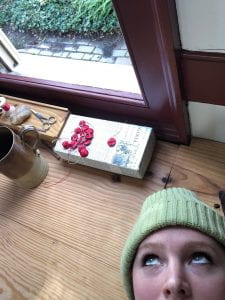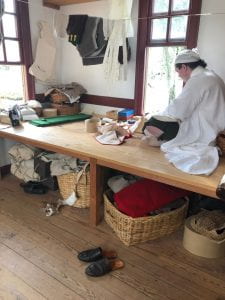Tailoring Poetry and Opening Windows
By Carrie Greif, WPAMC Class of 2019
The first time I was able to lay in front of an open window in 2019 was on a work platform at the Tailor’s Shop in Colonial Williamsburg (or CW as the insiders say). I listened to birds chirp outside while an apprentice tailor and fashion scholar explained the origins of codpieces. For those who may not be dialed into the decorative arts world, a codpiece is a pouch that attached to a man’s breeches or close-fitting hose to cover the genitals. They came in a variety of forms from purely functional to finely ornamented. A fire gently crackled as the story of codpieces from their 14th century origin to their stylistic downfall in the 1590s echoed through the workshop. Codpieces were out of fashion far before Colonial Williamsburg’s interpretive time frame of 1699 to 1780. They have no historical relevance to the site. It didn’t matter. Lying in the sun while the linen shirts hung on a line over my head gently swayed in the breeze blowing through open windows, I had what philosophers have long referred to as an aesthetic experience. That is to say, I was removed from my sense of self and able to connect with something much bigger and deeper.

The author takes a selfie on a tailor’s platform that was used by tailors to sew clothes and prevent cloth from getting on the ground. Image courtesy of author.
The main interpretative goal of the tailor’s shop is to expand visitors’ understanding of the wide range of skills used in the trade. The tailors want visitors to understand that bespoke garments were what all men and women wore in the colonial period – not just the wealthy and elite. They also want to illuminate that colonial men had a vast array of fabrics and styles to choose from. While our CW Tailoring Guide and consummate scholar, Michael McCarty, spoke, our eyes were free to roam the shop. Reds, blues, whites, creams, polka dots and cheetah prints were proudly (and loudly) on display. The spectrum of sartorial possibilities did not need to be stated for the careful observer; it could be felt. And it’s the feeling that CW does best.

A small sample of the myriad cloth pieces on display in the Tailor’s Shop. McCarty explained to us that this range of colors and prints was not available in most Tailor’s Shop. But, having the spectrum of cloth in the store enabled visitors to get a better understanding of the spectrum of available cloth and clothes from the colonial era. Image courtesy of Eliza West.

Michael McCarty stands behind the tailor’s counter and explains the fundamentals of breeches. Image courtesy of Eliza West.
Tailoring is not a dramatic craft. There aren’t loud noises, hot fires or shelves lined with heavy tools like there are in many of the other trade shops at CW. It is an inherently quiet and calculated trade. The very word, “tailoring,” meaning the art of cutting, is like writing when its going well; it’s not the most exciting thing to watch. That fact put a lot of pressure on McCarty to illuminate the craft. He did not disappoint. One of a tailor’s most important tools being his scissors, McCarty put his to good use as he fluidly measured a brave classmate for a pair of breeches (sans codpiece for those who may have been wondering) by making a series of geometric cuts in a long strip of white paper. He then swiftly used chalk and a pattern to draw cutting lines onto a white woven textile, remembering precisely how each notch on the long strip of paper related to my classmates’ body. Hardly looking down, he cut the pattern out passed it off to journeyman tailor Tim Louge who stitched the garment together in a matter of minutes while sitting, “tailor style,” or cross-legged, on the very platform where I would later rest my head.

Tim Louge sews together my classmate’s breeches on a tailor’s bench in front of an open window. Image courtesy of Eliza West.
While the tailor’s craft depends on his scissors, pins, and needles, it is stored in the artisan’s mind. Wheelwright’s or blacksmith’s trades demanded a high volume of expensive and large tools. Tailors could have shops, but they didn’t need them to practice their craft. McCarty mentioned that if one was a bit strapped for cash, a tailor could be found in a local pub. Provide that tailor with board, food and drink and one could receive a full suit in two-day’s time. If all men in the colonial period were wearing tailored clothes, one might expect a spectrum of quality tailors in the trade itself. To some extent there was, but the range of price was not directly related to the quality of the construction, it more directly correlated to type of fabric garments were made from. Tailors need a particular level of skill to make a shirt regardless of it was for an enslaved man or gentleman. The real differentiator in price was in the quality of fabric and high-end fabrics were often sold from merchants outside the tailor’s shop.
Throughout my time at Winterthur I have been lucky enough to see, touch and “connoise” tailored clothes, particularly breeches, a number of times. Despite my experience studying them, it took the CW tailor’s shop opening the window into their world for me to comprehend them as a garments, as the carefully-made product of a tailor’s training and skill. Stylistic elements like gathers in the back that create a comfortable amount of room in one’s seat are expressive details that only exist thanks to tailor’s knowledge both of the trade and of the potential of materials. Breeches shaped lived experience, but they were also the result of a tailor’s lived experience. Like poets, tailors crafted expressions of time, place and people.

Leave a Reply